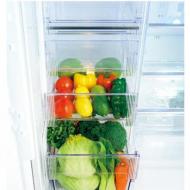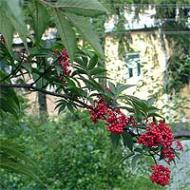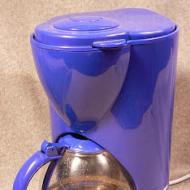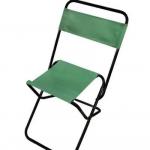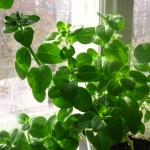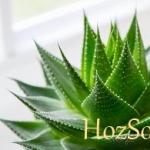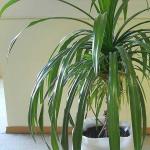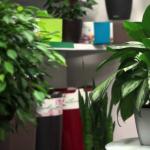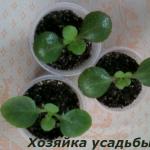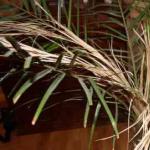
Elderberry is an ornamental tree and shrub. Elderberry: planting and care, pruning and propagation
Or red- Sambucus racemosa L.
The homeland of the mountains of Western Europe, like wild ones - from the Baltic states to the Ciscaucasia. Available in nature reserves in the European part of Russia. Grows in the undergrowth of dark coniferous and mixed forests. Photophilous mesophyte.
Deciduous shrub or small tree up to 5 m tall, with a wide, ovoid dense crown; compound, odd-pinnate, light green leaves up to 16 cm long, with 5-7 elliptical, pointed, sharp-toothed leaflets. The flowers are greenish-yellow in dense, ovate or oblong-ovate inflorescences, up to 6 cm in diameter. Flowering duration is 15-20 days. The fruits are bright red, small, berry-shaped, in dense clusters. Leaves and branches have an unpleasant odor.
In GBS since 1952, 1 sample (1 copy) was grown from seeds obtained from the Czech Republic. Shrub, at 3 years height 1.9 m, crown diameter 140 cm, grows from 13.IV ± 10 to 10.X ± 1 for 180 days. In the first 3 years it grows quickly. Blooms from 15.V ± 7 to 30.V ± 10 for 15 days. It bears fruit from the age of 3, the fruits ripen 22.VII ± 8. Weight of 100 fruits is 6 g. Weight of 1000 seeds is 2.6 g. Winter hardiness is high. Seed viability 86%. Produces plants from seeds of GBS reproduction. 96% of cuttings take root when treated with a 0.05% IBA solution.
It grows quickly, especially in fertile, fairly moist soils. Tolerates partial shade, less demanding on soil conditions than black elderberry. In harsh winters, annual shoots may freeze. It is recommended to grow from the latitude of Moscow and further south. Tolerates city conditions well and gets a haircut. Propagated by seeds, cuttings, layering. It is very beautiful during the fruiting period, especially when grown in standard form, does not lose its decorative effect for decades, and is also attractive during flowering. Good for group planting, on the edges and as undergrowth. Decorative forms are used in single plantings and small groups. In culture since 1596.
 Photo by Nadezhda Dmitrieva
Photo by Nadezhda Dmitrieva
It has several decorative forms: low(f. nana) - dwarf, compact; feathery(f. plumosa) - the leaves are purple when blooming, with jagged leaves dissected almost to the middle; fine-leaved(f. tenuifolia) - the leaves of the compound leaf are deeply dissected into very narrow segments, purple when blooming, the foliage is very lacy; purple(f. purpurea) - with pink or purple flowers; yellowish f. flavescens) - with yellow fruits with an orange side.
Most commonly used dissect-leaved(f. laciniata) form - tent-shaped shrub or small tree up to 5 m tall, with early-blooming opposite, large, odd-pinnate leaves, consisting of 2-3 pairs of finely dissected leaves, turning yellow in the fall. Numerous pale greenish-yellow flowers are collected in erect, large spherical or ovoid inflorescences. The fruits are small, shiny, bright red, almost spherical. Shade-tolerant, grows quickly. It develops better on fertile, loose soils with good lighting. If it loses its decorative properties, it needs severe pruning. Looks very good in standard form. Propagated by sowing seeds, layering, cuttings and grafting.
In GBS since 1952, 4 samples (23 copies) were obtained from cuttings from the culture; there are plants of seed and vegetative reproduction of GBS. A small tree, at 17 years old, height 2.0 m, crown diameter 150 cm. Other information is the same as for the main species.
"Plumosa". In the GBS since 1952. In the arboretum, 3 specimens were obtained from living plants. The tree, at 11 years old, is 2.5 m high, crown diameter 200 cm. Can reach 3.5-4.5 m in height. Grows from mid-April to late September - early October. Growth rate is fast. Blooms in the second half of May - early June. Fruits ripen in late July. Winter hardiness is average. Seed viability 86%. 100% of summer cuttings take root. Recommended for widespread use in landscaping.
"Plumosa Aurea". A shrub up to 1.5-2.0 m high, with beautiful golden cut foliage; grows quickly. This is one of the most spectacular yellow-leaved shrubs, feeling best in light partial shade. In the shade, the leaves turn green. Particularly beautiful in the spring, when Lace reddish leaves surround dense inflorescences.The flowers are yellow-green, replaced by bright red fruits, lighting up like rubies against a sunny yellow background.
In GBS since 1977, 1 copy. grown from seeds obtained from the crop. Shrub, height 2.0 m at 8 years, crown diameter 150 cm. Grows from mid-April to early October. The growth rate is average. Blooms in early to mid-May. The fruits are not marked. Winter hardiness is average. 100% of summer cuttings take root.
"Sutherland Gold". It is distinguished by greater leaf dissection (deeper) and significantly greater resistance to sunburn than the Plumosa Aurea variety.
Botanical classification within the genus Sambucus, including the species Sambucus nigra, has been subject to much controversy and remains unclear. The reason for this is the wide distribution of plants of this type and their high morphological variability.
The genus includes approximately 9 to 40 species of herbaceous perennials, deciduous trees and shrubs, growing naturally in forests and thickets of temperate and subtropical regions.
Certain types of crops are in demand as medicinal raw materials, and varietal forms of the plant can easily compete with ornamental trees and bushes that are popular in landscape design. Elderberry is undemanding in care and can be recommended to beginning gardeners.
Varieties and types of elderberry
One of the most common representatives of the genus is the European black elderberry (Sambucus nigra), which is a dense, highly branched shrub or not very tall tree. It is characterized by fairly rapid growth (up to 60 cm per year), reaching a height of 2 to 6 meters, depending on the variety.
The leaves are pinnate, consisting of small leaflets up to 30 cm long. In wild shrubs they are dark green; the color of the leaves of ornamental varieties can be light green, variegated and even almost black.
Small, creamy white or pink fragrant flowers are collected in flat corymbose inflorescences with a diameter of 10-20 cm. Numerous, spherical fruits appear in early autumn. Abundantly fruiting bushes have so many berries that the stems bend under their weight.
The fruits remain on the bushes even after the first frost. Elderberry blossoms are so beautiful that even wild shrubs attract attention during this period.
Elderberry "Aurea" has golden leaves early in the season and yellow-green leaves in summer.

"Aureomarginata" - foliage with golden edges. The height of the bush is about 3 m.
"Aureovariegata" - distinguished by yellow spots on the leaves.
"Gerda" is a shrub up to 3.5 meters high with dark purple leaves and pink flowers.
“Guincho Purple” - the dark purple, glossy leaves of a small shrub acquire a red tint in autumn, the shoots are also purple, and the inflorescences are rich pink.
A fascinating variety of black elderberry, 'Black Lace', also known as 'Eve' elderberry. It stands out among other varietal forms with openwork, deeply dissected purple-violet leaves. The inflorescences are pink and appear in late spring. In autumn the leaves turn red.

Elderberry "Black Tower" or "Black Tower" is a slow-growing columnar shrub 2 m high and 1 m wide. Young green leaves become lilac-violet over time. Ideal for small gardens. The inflorescences are pink.
"Linearis" is a bush up to 2 meters in height with very narrow, rugged leaves.
Elderberry "Madonna" is a compact ornamental shrub with bright yellow-green leaves.

Elderberry "Laciniata" is a fast-growing compact bush up to 2 meters high with an openwork crown of deeply dissected leaves.

"Pulverulenta" is a dwarf bush about 1.5 m high. The varietal form is characterized by unusual colored leaves, almost white in spring. In summer, the green color begins to dominate and the leaves become variegated with white spots.
"Purpurea" has violet-green leaves when young, becoming bright green with age.
Blue elderberry is a small ornamental tree native to the western United States and Mexico. In season, the tree is decorated with lush inflorescences, and in the fall it is strewn with clusters of bluish-blue fragrant, edible berries similar to blueberries.

The red-brown bark of the plant contrasts effectively with the pale green color of the foliage. The disadvantage of this type is its low frost resistance.
Red elderberry (Sambucus racemosa) or elderberry racemosa is similar to other species, but with one important difference - its red berries are unsuitable for food, as they are poisonous, so the bush is grown as an ornamental plant.
Numerous bright red fruits against a background of feathery green leaves make the bush a bright accent in the autumn garden. This species also has several spectacular varietal forms.
 "Plumosa aurea"
"Plumosa aurea" Elderberry "Plumosa aurea" and "Sutherland Gold" are varieties with golden-yellow, lacy foliage that turns green in the shade. "Sutherland Gold" received an award from the Royal Horticultural Society for its high decorativeness.
 "Sutherland Gold"
"Sutherland Gold" "Lemon Lace" or "Lemony Lace" is a very hardy and showy plant with feathery light green leaves.

There are also varieties with purple foliage and pink flowers.
Elderberry (Sambucus ebulus). Perennial herb 1-2 m high with straight, usually unbranched stems. As it grows, it forms large groups with extensive underground rhizomes. The leaves are pinnate, 15-30 cm long. All parts of the plant are poisonous.

Siebold elderberry (Sambucus sieboldiana) native to East Asia. The species is named after the German physician and botanist Philipp Franz von Siebold. It is a powerful shrub with very large leaves and large inflorescences.
Planting elderberry in open ground
Bare-root bushes are planted in spring or November, plants in containers are planted throughout the season. Seedlings that are one or two years old take root best.
Elderberry is undemanding in care, but for the beautiful color of the foliage of ornamental varieties and abundant fruiting, it must be planted in a sunny place, protected from strong winds.
The crop prefers soil without stagnant water, fertile, rich in humus and nitrogen compounds, although it adapts well to poorer substrates, but then the flowering will not be so abundant. But acidic soil must be limed 2 years before planting elderberries.
Having chosen a place, start planting seedlings. Dig a hole measuring 50x50 cm and 60 cm deep. Prepare a fertile mixture of well-rotted manure (4-5 kg) and fertile soil taken from the pit.
It is also useful to add a tablespoon of potassium fertilizer and 50 g of phosphates. Mix everything well and pour 2/3 of the prepared substrate into the hole.
Place the tree's roots in the planting hole and adjust the planting depth so that the root collar is level with the soil surface. Fill the hole with the remaining soil and compact it, making a small depression around it for watering. Pour generously with 10 liters of water. Tree-shaped seedlings may need a rigid support to which they are tied for the first 2 years.
The shoots of all young seedlings are shortened by 10 cm immediately after planting and then a neat crown of the plantings is maintained using seasonal annual pruning.
Plant several seedlings at a distance of 2-3 meters from each other. The more air that can circulate between shrubs, the less likely it is for disease to develop. After planting, place a layer of garden or bark mulch around the root zone of the bush.
Features of elderberry care
At the beginning of spring, when the sun begins to heat up during the day and frosts still persist at night, the bark of large shoots may crack. To avoid damage, the shoots and trunk are covered with a layer of lime.
At the beginning of March, sanitary pruning is carried out for fruit species and, if necessary, formative pruning for decorative deciduous forms. Remove dead, damaged or diseased shoots.
Dense bushes are thinned out, side and unwanted branches that develop at the wrong angle are removed. To avoid infection, the cutting areas of large shoots are lubricated with garden varnish.
The crop tolerates the climatic conditions of the middle zone well, but in severe frosts the delicate elderberry varieties “Black Lace” and “Black Beauty” can freeze. In this case, the bushes are pruned, leaving only 20-30 cm to the soil level. Over the course of a season, the plant forms new dense shoots with decorative foliage. Anti-aging pruning is also carried out every 3 years.

After any type of pruning, when the buds have not yet blossomed, the elderberry is treated with a solution of Bordeaux mixture or other drugs with similar effects to prevent diseases and destroy pests. Repeated treatment is carried out in the fall after leaf fall. Diseased fallen leaves are burned.
During the period of flowering, active growing season and fruit formation, the crop needs fertilizing and watering. Numerous root shoots of shrubs must be regularly removed at the very beginning of growth.
At the end of autumn, before the onset of frost, the tree trunk area is insulated with fallen leaves or compost. An excellent insulation material is fallen snow, which is thrown onto the plantings.
Feeding
Caring for elderberries in the garden also includes fertilizing. When planted in well-fertilized soil, the crop grows well even without fertilizing, but in poorer substrates it is useful to feed with slurry or compost in the spring.
The crop responds well to nitrogen fertilizing with urea solution. Plantings are fertilized only in the spring. In summer, if necessary, add 25-30 g of balanced mineral fertilizer for each plant.
Watering
The crop loves moderately moist soils, so in dry summers it needs regular watering, about once a week for large plantings and 2 times for young seedlings. After watering, loosen the soil so that a crust does not form, which blocks the access of oxygen to the roots.
In a normal summer with periodic rains, the plantings do not need watering, but will not allow moisture to evaporate and protect the roots from overheating.
Elderberry propagation
When propagating elderberry using seeds, it should be taken into account that the resulting seedlings do not retain the varietal and even species qualities of the mother plant, so the crop is mainly propagated vegetatively.
Growing elderberry from cuttings
Green cuttings with 2-3 internodes, approximately 15 cm long, are cut in the summer just below the leaf node. All leaves are removed, leaving only one upper leaf stalk with two leaflets. Cuttings can root in water or soil.

To root in the soil, cuttings are buried in powder, which stimulates rapid root formation, and planted in a sand-peat mixture. The soil and cuttings are watered from a watering can and covered with a transparent bag, creating greenhouse conditions. The pot is placed in a place with diffused sunlight during rooting.

Ventilate the greenhouse periodically and do not forget to water the soil, keeping it moderately moist. Condensation from the bag should not fall on the leaves, as it can cause them to rot. Once they show signs of growth, you can remove the plastic bag. In October, young plants are planted in open ground.
Wood cuttings taken during spring pruning are also suitable for rooting. They are immediately buried in open ground and watered as needed throughout the season. More than half of the cuttings take root in this way.
Roots in the water. Green cuttings are placed in jars and placed next to the window. The water is changed every 3-4 days. After 7-8 weeks, the cuttings will have formed enough roots to be transplanted to a permanent location in open ground.
Reproduction of elderberry by layering
This method is the most effective, as it gives an almost 100% guarantee of obtaining new seedlings. The propagation technology is simple: young, non-lignified side shoots are tilted towards the ground and placed in prepared grooves with a layer of compost along the entire length of the shoot.
They are secured with metal brackets so that they do not straighten out and are covered with soil, leaving only the top of the branch unfilled. The following year, with the beginning of new growth, the rooted cuttings can be separated and transplanted to a new location.
As we can see, caring for elderberries, planting and propagation are not difficult even for a novice gardener.
Elderberry diseases
Tomato mosaic virus reduces the viability of elderberries, resulting in smaller yields and ultimately killing the plant. This is one of the most serious cultural diseases. The virus is usually transmitted by pollen and soil nematodes called Xiphinema.
Some weeds also carry the disease. It manifests itself as a change in the shape and color of foliage, chlorosis. The disease is practically untreatable.

Fungal diseases can cause leaf and stem spots. The spots may be purple, brown or yellow, depending on the fungus. In some cases, they spread throughout the entire leaf blade and lead to leaf fall.
Powdery mildew is also a fungal disease. It appears as a powdery, light white coating and weakens the plant over time. In the most severe cases, the plant's leaves may curl and fall off. The disease thrives in moist conditions.
As treatment and prevention, the affected parts of the plant are removed and burned and the bush is treated with fungicidal preparations. Diseases are caused by too high humidity combined with low temperatures and poor air circulation around the plantings.
Elderberry in garden landscape design
Bushes and trees fit into any garden style. Varieties with carved leaves are ideal for decorating oriental gardens as a replacement for expensive and capricious Japanese maples.
Several seedlings planted in a row will be an excellent alternative to a hedge. Dwarf forms of the “Lemony Lace” variety are planted in company with multi-colored coleus, phlox, Japanese spirea of the “Magic Carpet” variety, and small weeping crimson “Whitewater”.

A composition of low-growing varieties of elderberry, low and decorative deciduous shrubs such as barberry, privet, hawthorn, and flowering buddleia looks great.
Lush openwork varieties with purple or golden foliage will become a bright accent against the background of an emerald lawn. A composition of several varietal forms of a crop with different shades of foliage looks impressive.

Medicinal properties of black elderberry
Black elderberry is an almost iconic medicinal plant. Its valuable properties have been known since ancient times. Currently, thanks to laboratory research, we can already scientifically confirm the composition and effect of individual chemical compounds contained in elderberry flowers and fruits and use them safely.
Dried flowers and berries are used in herbal medicine. Flowers contain essential oils, flavonoids, tannins and mineral salts.
Tea made from fresh and dried flowers has excellent antipyretic, diuretic and expectorant properties. Raw materials are collected from mid-May on dry days, cutting off whole inflorescences. The drink is used to treat diseases of the upper respiratory tract and rheumatism.
Did you know that for colds, elderflower drink is much more effective than linden tea!
Externally it is used to wash the eyes for conjunctivitis, gargle, and treat burns.
Whole inflorescences are collected on a sunny day, when they have just begun to bloom. Dry in a well-ventilated, dark and dry room at a temperature not exceeding 35 °C.

The berries of the black elderberry bush ripen in late summer and September. They contain large amounts of vitamins A, B and C, fructose and trace elements. The fruits have laxative properties and act as a diaphoretic, diuretic, antipyretic and analgesic.
Berry decoction is used to rinse the mouth after tooth extraction, to treat migraines, diarrhea, to detoxify the body, and for metabolic disorders. The fruits are widely used in cooking and winemaking for the preparation of jams, juices, and tinctures.
Many novice gardeners who want to grow elderberry on their property are interested in the question: is elderberry poisonous or not? All parts of the fresh plant, including unripe berries, contain the glucoside sambunigrin and the alkaloid sambucine, which are toxic to the body.
Poisoning occurs when eating large quantities of unripe fruits. Its symptoms are: weakness, diarrhea, headache, dizziness, increased heart rate, shortness of breath. First aid consists of inducing vomiting and gastric lavage. However, heat treatment and the drying process completely destroy toxic compounds.
The Elderberry genus includes up to 40 species, the most decorative of which is the black elderberry. Planted on the plot, over time it will give you useful fruits. The plant does not require care and looks great in the garden, as can be seen in the photo.
Black elderberry is a large ornamental deciduous shrub or tree. The plant is a long-liver (up to 60 years). It grows 3-4 m in height, sometimes up to 7 m. The leaves are rich green, imparipinnate, dissected into 5-9 lobes, and when rubbed they emit an unpleasant odor. Small white or yellowish flowers are collected in loose corymbs. The fragrant aroma of flowers attracts many pollinating insects to the garden. The fruits are glossy drupes in loose clusters. The leaves, bark and trunk of black elderberry are moderately poisonous.
 Elderberry is very decorative both during the flowering and fruiting periods
Elderberry is very decorative both during the flowering and fruiting periods Elderberry blooms in June for 3 weeks. By September, edible, sweet and sour fruits ripen, which are consumed both fresh and processed (jams, preserves, wine).
The black elderberry species includes many garden forms. Among them there are bushes with a columnar (formerly pyramidal) and drooping (formerly weeping) crown. The most interesting varieties are presented in the photo. Among the species with unusual shape and color of foliage are:
B. fernifolia– the leaves are narrowly cut, and the white flowers have a musky aroma.
 Elderberry fern-leaved
Elderberry fern-leaved B. porphorolifolia- a form with purple or inky leaves and pinkish flowers with a pleasant strong scent. Popular varieties:
- "Purple";
- “Ginshu purple” is interesting due to the changing color of the leaves: green changes to ink, and in the fall to bright red;
 Variety "Ginshu purple"
Variety "Ginshu purple" - "Black Beauty";
- "Eve".
B. powdery– characterized by the presence of yellow or white spots on the foliage. Interesting varieties:
- "Luteovariegata" - with a yellow border along the leaf;
- "Pulverulenta" - foliage densely covered with white plaques;
 Variety "Pulverulenta"
Variety "Pulverulenta" - "Madonna" - foliage with multiple yellow spots.
Of the variegated varieties, it is worth highlighting “Albo-variegata” - with white-variegated leaves, “Aureo-variegata” - with golden-variegated leaves and “Aurea” with yellow leaves.
 Variety "Aurea"
Variety "Aurea" The “Witches Broom” variety reaches a height of only 20 cm, blooms rarely and does not bear fruit at all. The “Kazachka” variety, on the contrary, is distinguished by abundant flowering and fruiting.
Subtleties of landing
Black elderberry is a fairly hardy plant. Well-lit areas are chosen for planting. The plant can tolerate shade, but its decorative appearance suffers significantly.
Important! Forms with bright and variegated foliage colors are planted only in sunny areas. In the shade, the leaves become faded and lose their decorative effect.
Due to the property of elderberry to repel flies and other harmful insects, it is often planted near outdoor toilets and drainage pits. Fruit bushes and trees growing nearby will promote cross-pollination.
For normal development, black elderberry prefers fertile, slightly alkaline soils (loams). If the reaction is acidic, the soil should be deoxidized with lime in advance.
 To plant black elderberry, choose fertile soils.
To plant black elderberry, choose fertile soils. Planting of seedlings is carried out in spring or autumn, when the weather is warm. The planting hole is dug to a depth of about 40-50 cm and generously filled with organic matter and phosphorus-potassium fertilizers. The root collar is not deepened. The seedling is sprinkled with earth and compacted under the weight of an adult’s body. Until the seedling takes root and begins to grow, it needs to be watered regularly. The young bush blooms in the third year.
Growing and care
Caring for black elderberry comes down to watering, keeping the soil clean and loose, and pruning. The plant can tolerate short-term drought, but prefers moist soil without stagnant water. On moist soils, elderberry looks juicy, blooms well, and the fruits are plump.
Advice. To maintain soil moisture in the hot season, it is recommended to mulch the trunk circle of black elderberry with sawdust, leaf litter, peat or other materials.
Pruning of bushes is carried out for decorative (to give shape to the crown) and rejuvenating purposes. In young plants, frozen and damaged branches are pruned in the spring. In summer, the bushes quickly recover. To rejuvenate old bushes, pruning is short, leaving no more than a quarter of the trunk. New shoots will grow over the summer.
Important! Pruning is especially important for fruiting elderberry varieties. Upon reaching the age of six, the branches stop bearing fruit. The peak of fruiting is observed on two to three year old branches.
The plant is almost never affected by diseases. The crown of the bush is sometimes attacked by aphids and spider mites. If signs of trouble appear, the plant should be immediately treated with fungicides.
 Elderberry fruits ready for harvest in autumn
Elderberry fruits ready for harvest in autumn The fruits are harvested after full ripening. This happens in mid-September. The brushes are cut off entirely. The shelf life of the berries is short - 8-10 days in the refrigerator, so they are often processed. Uncut brushes can remain on the branches all winter. Elder flowers are prepared for medicinal purposes by cutting and drying them in the shade of trees or in the attic.
Application of fertilizers and fertilizers
Fertilizers for elderberries are applied in early spring. Solid mineral fertilizers are scattered in a circle near the trunk, after which they are embedded into the soil by harrowing to a depth of 10-15 cm, soluble fertilizers are applied with watering.
Advice. Black elderberry is very responsive to the addition of urea.
From organic matter, solid manure or compost is used, as well as infusions of litter. It is better to introduce them in the fall, every other year.
 For black elderberry, fertilizing once a year is sufficient.
For black elderberry, fertilizing once a year is sufficient. Reproduction
Methods for propagating black elderberry:
- seminal;
- green or woody cuttings;
- layering.
Elderberry seeds black autumn is sown in the soil. After a year, the seedlings reach a height of 50 cm and are ready for transplanting.
Important! Black elderberry grown from seeds loses most of its varietal properties. It is impossible to predict which plant will turn out, highly decorative or unsightly.
Green cuttings immediately after cutting they are planted in a temporary bed. Woody shoots are cut in the fall and stored in a cool place until spring. In the spring, cuttings 25 cm long are cut, leaving at least two pairs of buds, and also planted in a temporary place for rooting. The soil on the site is always kept moist. By autumn, the cuttings form roots and young shoots. For the winter, seedlings need shelter. The grown bushes are transplanted to a permanent place.
 Green elderberry cuttings
Green elderberry cuttings For getting layerings Black elderberry branches are buried in the grooves in the fall, leaving the top on the surface. In the spring, young shoots will grow in this place; it is recommended to separate them from the mother bush after a few years.
Growing black elderberry on your own plot is not at all difficult. She needs basic care that does not require special skills. In return, the plant will give you a pleasant aroma during flowering, decorative foliage in the summer and healthy berries in the fall.
Planting and properties of black elderberry: video
Elderberry ( Sambucus) – shrubs or small trees (3-5 m), many of which are distinguished by decorative fruits. Elderberry red, or cluster ( Sambucus racemosa) has several decorative forms, is unpretentious and also repels mice. Black elderberry (Sambucus nigra) also has decorative forms, and its fruits are eaten.
Black elderberry is less frost-resistant, but still quite resilient, especially when planted in a place protected from cold winds. Easily restored if the shoots are frozen.
The Canadian elderberry (Sambucus canadensis), which also has decorative forms, is similar to it. This is a hardier plant. The listed species are shade-tolerant and moisture-loving to varying degrees. Prefer rich soils. They tolerate pruning well, including to the stump. Elderberry is propagated by seeds, and cultivated forms by cuttings.
What black and red elderberry looks like, how the bush blooms (with photo)
What elderberry looks like, look at the photos below and admire its unique beauty:



This typical example of the honeysuckle family is an extremely attractive plant, surrounded by unusual beliefs. Healers consider it a talisman against evil spirits and a useful material for creating medicines. Every summer resident, rural resident, and even an inhabitant of a metropolis who is far from gardening probably knows what an elderberry looks like.
There is a whole palette of varieties and types of elderberry, about 40 of them are known. The characteristic aroma of the foliage repels annoying insects (for example, flies), rodents and other pests. Bushes are often planted in the area of cesspools and compost pits, outdoor toilets, and manure heaps.
In addition to the ubiquitous red and black elderberry, other varieties of this plant are also cultivated, for example:


Canadian


Blue


Siberian


grassy


Zimbolda
How beautiful different types and varieties of elderberry look in all kinds of territories, check out the photo:




Red and herbaceous elderberry are inedible plants; they contain cyanoglycosides. Black elderberry, on the other hand, is known for its healing qualities. Sometimes it can be difficult to distinguish the poisonous berries of the scarlet elderberry from the medicinal fruits of the black elderberry. If you are not completely sure which plant is in front of your eyes, you should not take risks.
Photos of black and red elderberry are offered below, view them to see the important differences:




Most elderberry varieties are quite suitable for the Moscow region; they can be planted even in the North-West. If you provide the plant with reliable insulation for the winter, it will not suffer from severe frosts. Decorative varieties are cultivated for the purpose of decorating personal plots, cottages, gardens, and park areas. Elderberry is in great demand in landscape design, because the foliage and flowers of this plant are extremely beautiful and can have a variety of colors and shapes.
How to propagate elderberry by cuttings and other methods
Elderberry is bred by cuttings, sowing seeds, dividing bushes or forming layering. Propagation of elderberry by cuttings is a convenient and most well-known method. Both lignified and young cuttings are used. They must contain at least 3 internodes and several upper leaves. The material is harvested in June-July.
Cuttings (10-12 cm) cut from an adult plant are placed in a sand-peat mixture and covered with a jar on top. It is advisable to treat the part of the stem that will come into contact with the ground with a root former before planting - this composition will speed up the rooting process significantly. Regular watering is required. In autumn, seedlings are sent to open ground.
Seeds are collected around the end of October, sowing is carried out immediately or in the spring. If the procedure is planned for the spring, then the seeds must be prepared properly:
- they are pre-soaked for 3-6 days;
- water is changed daily;
- then the seeds are mixed with wet sand, placed in an airtight container, and placed in the refrigerator for 50-60 days.
Sow seeds to a depth of 2-3 cm, maintaining the distance between rows. In the first summer season, seedlings grow noticeably (up to 0.5-0.6 m); at the age of 1 year they are transplanted to a permanent “habitat”. Autumn sowing does not require pre-treatment of seeds.
The key features of this method of planting and caring for elderberries are shown in the photo - look through them to make sure you do all the steps correctly:


How to propagate elderberry to achieve almost 100% survival rate of the young plant? The best option is the formation of layering, which is added dropwise from an adult bush in the fall or spring. A branch of a 2-3 year old plant is bent and placed in a trench dug the day before. Compost is added to the bottom of the groove. The shoots are securely secured with a bracket made of metal, dug in well, leaving the top of the branch above the ground (it is cut off by 10 cm after planting). The plant needs frequent watering, especially until it takes root.
Dividing the root system is done in the fall. A large, perennial bush is dug up and divided into equal sections. To do this you will need a saw or a sharp ax. Places of cuts/cuts are coated with ash and immediately planted in prepared trenches or containers (if spring planting is planned).
How to plant elderberries correctly
To get a strong, beautiful plant, you need to know how to plant elderberries correctly. The shrub is not particularly picky about the soil on which it grows, but preference should be given to loam and soddy-podzolic soil with a pH of 6.0-6.5. Excessive soil acidity is neutralized by liming (dolomite flour is added).
The plant can tolerate excessive humidity and moderate shade, but it definitely cannot withstand drought - it grows poorly, loses its decorative effect, and can even die. This must be taken into account when choosing a place for planting and during further care.


Shrubs are planted in autumn or spring, depending on the method of propagation. In any case, the hole is dug in advance (a month before the intended planting). The depth of the pit is 0.8 m and its circumference is 0.5 m. Earth from the upper layers of the ditch is thrown in one direction, and from deeper layers in the other.
A nutrient “cushion” is placed at the bottom of the trench, consisting of the following components:
- soil excavated from the surface layers;
- 7 kg of high-quality humus;
- 50 gr. phosphates;
- 30 gr. potassium fertilizer.
All ingredients are thoroughly mixed. Cover 2/3 of the mixture with the bottom of the dug hole. On the day of planting, the inside of the trench is slightly loosened, the root part of the seedling is lowered into it, and sprinkled with soil previously extracted from the lower layers. Cover the top with the remainder of the fertilizer soil mixture. Compact the area around the trunk and water it with water (1-15 l). When the liquid is absorbed, the seedling is carefully tied to a peg.
For some basic stages of planting black elderberry and caring for it in the future, see the photo:




Although the plant is unpretentious, it still needs to be given some attention, otherwise the shrub will not be able to fulfill its decorative functions.
The nature and scope of care activities depends on the season:
- Spring. In March, there is a risk that the plant will suffer from temperature changes, when during the day the bark is strongly heated by the sun's rays and rapidly cools at night. To prevent damage, all forks are painted with lime mortar. If there are cracks or injuries caused by rodents on the trunk, then all such “wounds” should be washed with a solution of potassium permanganate and covered with garden varnish. On a fine, non-cold day, begin pruning. Dried, unhealthy, frostbitten shoots must be eliminated. Using pruners, the crown is given a neat appearance. The cuts and cut areas are treated with Nitrafen or Bordeaux mixture.
- Summer. After flowering, elderberries are sprayed with special preparations to prevent damage by harmful insects and powdery mildew. The soil in the tree trunk area is loosened and kept moist. In bushes that have been frostbitten during the winter, the growth of root shoots is activated. They are destroyed until they “overtake” the elderberry bush itself.
- Autumn. Autumn care involves watering, harvesting, and preparing for winter. In September, the medicinal berries of the black elderberry ripen, they are harvested and subjected to appropriate processing. After this, sanitary pruning is performed. When the plant loses its leaves, it is treated with fungicides and insecticides. At the end of the month, they dig up the soil around the trunk and insulate the area near the trunk with peat, humus or straw. Sometimes fertilizers are applied first.
- Winter. To prevent root frostbite, snow is periodically piled up around the trunks. They also make sure that the insulating mulch does not collapse.
Varieties of all types of elderberry need sufficient water: black, red, Canadian and others. The frequency of watering can be reduced or even eliminated only in rainy summers and when the tree trunk area is mulched. Mulch (compost, straw, rotted manure) slows down the rate of moisture evaporation from the soil. During particularly hot seasons, 10 liters of water are poured under each bush, once a week.
Type of black elderberry: varieties for the Moscow region, care and cultivation (with photo)
The most popular and recognizable species is the black elderberry. Look at the photo for its varieties - all of them, with proper care, can perform decorative tasks:


To better understand what black elderberry looks like, read the description below. This is a very productive shrub or small (no taller than 10 meters) tree. Loves sunlight, but also does well in the shade. Adult specimens have branched stems, gray bark, rather large (10-30 cm) odd-pinnate leaves, consisting of 3-9 separate segments. Planting black elderberry and caring for it in the future are simple.
The flowers are collected in wide shield-shaped inflorescences up to 25 cm in diameter: snow-white or with a slightly yellowish tint, less often pale pink. To find out how elderberry blooms, you will have to wait until spring and summer. During flowering, it emits a characteristic aroma that attracts honey harvesting insects. Black-purple, glossy fruits with 2-3 seeds and scarlet pulp ripen closer to September. They contain persistent pigmenting substances.
The berries of the black elderberry bush have a sweet and sour taste; the fruits, as well as the inflorescences, contain many biologically active components. Therefore, growing black elderberry is very important for alternative medicine.
Medicinal infusions with valuable properties are prepared from plant raw materials:
- anti-inflammatory;
- antiseptic;
- sedatives;
- laxatives;
- antipyretic;
- bile-, diuretic.
The raw materials are also used for external use for hemorrhoids, burns, diaper rash, ulcers, and wounds. The fruits are used to make delicious jam, marmalade, compotes, and make liqueur. There are contraindications for use (pregnancy, Crohn's syndrome, colitis, etc.). Leaves and bark are toxic to humans.
Growing and caring for black elderberry has no distinctive features; it is carried out according to the general principles described in detail in the article. Black elderberry is also propagated using standard methods - each gardener chooses the most suitable technique for himself.


Aurea. A lime-colored crown grows.


Luteovariegata. The leaves are initially bright yellow in color, later becoming white-yellow.


Aureo-variegata. The variety is characterized by golden-variegated foliage.


Albomarginata. The leaves are spotted, edged with a white stripe.


Argentea. There are green blotches on the white leaves.


Guincho Purple. In spring the crown is green, in summer it is bright purple. The flowers are pink and fade a little over time.


Black Beauty. Purple leaves, pink inflorescences with a pleasant citrus aroma will conquer every person. The purple-black berries are edible.


Rotundifolia. Slow growing bush with wide leaves. The inflorescences are delicate, not abundant.


Sampo. A valuable variety for industrial production with average cluster parameters, but large, appetizing fruits.
Due to their relative immunity to frost, most of the described varieties of black elderberry are also suitable for the Moscow region with its strict climate.
Before using parts of a particular variety for treatment or food, you need to consult with an experienced herbalist or herbalist. This is necessary in order not to confuse edible species with poisonous ones, and not to cause harm to health with incorrect dosages.
Type of red elderberry: photos and descriptions of varieties


Red elderberry ( Sambucus racemosa) - a small deciduous tree begins its ancestry on the mountain slopes of Western Europe. Its distinctive feature is its specific smell and beautiful, but inedible small red fruits. Externally, the plant becomes especially attractive just during fruiting. The specimen is quite shade-tolerant, but looks more impressive in good lighting conditions.
Red elderberry has very interesting, decorative varieties that successfully withstand formative pruning and unfavorable weather conditions:


Nana. Dwarf, compact form. It has a nice golden crown and notches along the edges of the leaves. The flowers are green-yellow, the berries are bright scarlet.


Sutherland Gold. It differs from Nana by a more pronounced dissection of the leaf border. The variety is resistant to sunlight.

